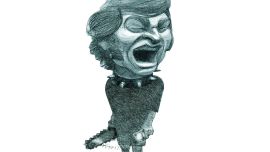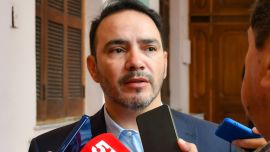The shock of the assassination attempt against Vice-President Cristina Fernández de Kirchner is quite rightly uppermost in public debate as a challenge to the democratic system, both in the action itself and the response, but the real trends lie elsewhere. The bullet aimed at the vice-presidential visage which never left the pistol is being followed by a furious volley of shots likewise jammed in the barrel – one display of solidarity after another (the Merlo rally, last Wednesday’s general strike, etc.) is announced only to come to nothing, accompanied by sound and fury over legislation against “hate speech” which can likewise only end up stillborn. Yet all that is not the real story which, as usual, is to be found in the economy – in the foreground a massive inflow of soy export dollars lured by this month’s favourable exchange rate and behind the scenes cutbacks extending well beyond the customary postponements of public works. In short, shifts in the fiscal, monetary and economic picture whose dimensions and results, like Economy Minister Sergio Massa’s ongoing visit to the United States, can only become clear in hindsight.
But before looking closer at this week’s economic developments, both the government’s strategy in general and “hate speech” legislation in particular need to be questioned since they cannot only be dismissed as the distractions which they also are. Instead of milking this attack to score points over the opposition, media and judiciary, the government could have taken the high road, as now being signposted by the Venice Festival film Argentina, 1985 reflecting the groundswell of national unity inspired by the 1985 junta trial and crystallised two years later in the joint stand taken by President Raúl Alfonsín and Peronist opposition leader Antonio Cafiero against the Easter rising of the military carapintadas – in the end this did not win the election for the government (or Cafiero) but it saved democracy, which is more important.
The proposals for a law against “hate speech” claims merely to follow similar legislation abroad yet they seem to be confusing their target – the other laws are against incitement to violence, racism, anti-Semitism, sexual harassment, etc. and not any criticism feeding polarisation as an alleged hotbed of political violence while they are aimed at the social networks as the real home of hate speech, not the media as a whole. The 2017 German law, for example, obliges better policing from the giants (Google, Amazon, Facebook, Apple, Microsoft, etc.) instead of arrogating state powers. Not that any such legislation is out of order (even if even the worst expressions can arguably serve as an outlet for violence rather than their cause) but the freedom of expression must be jealously guarded.
Without minimising the institutional importance of these issues (even if they mostly take the form of hot air over a bullet which never left the gun) or ceasing to deplore the lost opportunity to consign a destructive polarisation to the past, the week’s most concrete story remains the massive influx of soy export dollars – our press times do not allow us to give a final total for the week but it was impressive.
Yet the “soy dollar” of 200 pesos remains a short-term expedient unlikely to serve the economic health of the country or even the electoral health of the government. The concession (which should not necessarily be seen as pampering the farmers, given their export duty burdens this century) is aimed at bringing Central Bank reserves in line with the agreement with the International Monetary Fund even though there is a strong case for suspecting that the real aim of these dollars is to ensure the imports to sustain the growth of the first half of this year. Yet there are at least two problems dogging this success story. Firstly, the soy harvest is finite (even more so with this year’s dry weather) – when the government advanced next year’s tax collection last month, it can always demand it again next year, even at a huge cost in credibility, but the export dollars entering this month will not be around in future months. Secondly, somebody needs to explain how the Central Bank can buy dollars from exporters for 200 pesos and then sell them to importers for 140-150 pesos without running up a huge deficit – nominal reserves might be boosted but will the IMF accept the underlying red ink?
Yet Massa’s meetings with the IMF, the investigations into the assassination attempt and many other things are all stories to be continued next week.


















Comments